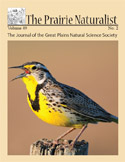Great Plains Natural Science Society

The Prairie Naturalist
Date of this Version
6-2006
Document Type
Article
Citation
The Prairie Naturalist (June 2006) 38(2): 101-111
Associate editor for ichthyology: Brian G. Blackwell
Abstract
Little information is available regarding the biology and population characteristics of pumpkinseed (Lepomis gibbosus), especially in South Dakota, a state at the western edge of the species native range. South Dakota Department of Game, Fish and Parks summer trap net survey data, collected 1998 to 2003, suggests the Enemy Swim Lake population has low abundance (0.4-2.9 per trap net night) and moderately high size structure (proportional stock density [PSD] ranges between 71 and 91). To further examine the biological characteristics of the Enemy Swim Lake population, pumpkinseed was collected from Indian Bay with trap nets during May 2003. Total length (TL), weight, and sex were recorded for 88 fish. In addition, gonads, livers, and viscera weights were recorded for calculating organosomatic indices, and sagittal otoliths were removed for aging. Relative abundance, PSD, and relative weights (Wr) were similar to other regional populations. The sex ratio (F:M) of sampled fish was 1.5. Fish age ranged from 2 to 5 years; mean pumpkinseed age was 3. The annual survival rate for age 3 to 5 was estimated at 0.25. Ultimate length for the population was estimated to be 223 mm (K = 0.38, t0 = -0.67) and mean TL increments were 27, 16, and 14 mm for ages 2 to 3, 3 to 4, and 4 to 5, respectively. There was no difference for total length (P = 0.57), weight (P = 0.37), or Wr (P = 0.88) between sexes, but visceral somatic (VSJ; P < 0.0001) and hepatosomatic (HSI; P < 0.0001) indices for females were greater than males. Relative weight and fish TL were correlated positively (P < 0.0001), and Wr was correlated positively with female and male VSI (P = 0.0031 and 0.0144), female HSI (P = 0.0008), and female gonadosomatic index (GSI; P = 0.0039). Because these biological characteristics are seldom reported, we anticipated this information might be useful for population comparisons throughout the range of pumpkinseed.
Included in
Biodiversity Commons, Botany Commons, Ecology and Evolutionary Biology Commons, Natural Resources and Conservation Commons, Systems Biology Commons, Weed Science Commons


Comments
Copyright 2006, Weimer and Brown Used by permission